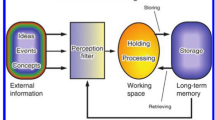Summary
Following the general educational project of the Centre for Human Evolution Studies of Rome, this paper considers the importance of the development of fundamental conceptions in chemistry. Specifically, an “anticipative” chemical education, which would foster a more complete understanding of life sciences, is proposed through an historical approach to the development of fundamental conceptions in chemistry.
The modern conception of “Chemical Communication”, in relation to dissipative chemical systems is emphasised, starting from the description of Belusov's oscillating reactions, and the utility of an evolutionary conceptual approach to chemical education, aimed at widening the scope of chemistry and providing a better understanding of brain chemistry, is discussed.
Similar content being viewed by others
References
Bachelard, G. (1978)The new scientific spirit, Laterza.
Degn, H. (1972) Oscillating chemical reactions in homogeneous phase.J. Chem. Ed., 49(5), 303–307.
Dirac, P. (1926) On the theory of Quantum Mechanics. InProc. Roy. Soc. A., 112/8, 661.
Epstein, I.R.et al. (1983) Oscillating chemical reactions.Scientific American, March, 96–108. See also: Reazioni Chimiche
Oscillanti, N.Le Scienze, 177, May 1983, 86; and Walker, J. (1980) Chemical systems that oscillate, InChemtech., 320–323.
Field, R.J. (1972) A reaction periodic in time and space.J. Chem. Ed., 49(5), 309–311.
Glansdorf, P. and Prigogine, I. (1977)Thermodynamics of structure stability and fluctuations. Wiley Interscience.
Hoppe, R. (1980) On the symbolic language of chemist.Angew. Chem. Int. Ed. Eng., 19, 110–125.
Kuhn, T.S. (1969)The structure of the scientific revolutions. Einaudi.
Kuhn, H. and Waser, J. (1981) Molecular self-organization and origin of life.Angew. Chem. Int. Ed. Eng., 20, 500–520.
Lambert, J.L. and Fina, G.T. (1984) Iodine clock reaction mechanisms.J. Chem. Ed., 61(12), 1037–1038.
Leicester, H.M. (1978)History of Chemistry. Isedi.
Partington, J.R. (1970)A history of chemistry. MacMillan, London.
Prigogine, I. and Stengers, I. (1981)The new alleance. Einaudi, 152.
Solov'ev, J.I. (1981)The evolution of chemical thinking. Mondori-Est.
Stranges, A.N. (1984) Reflections on the electron theory of chemical bond 1900–1925.J. Chem. Ed., 61(3), 185–190.
Trimarchi, M. (1983a) An integrated neuropsychophysilogical theory on the lateralization and codification of the cerebral hemispheres.The Brain and the Integration of Sciences (1st half year 1983). A.D.E.-C.E.U. Publishers, Rome.
Trimarchi, M. (1983b) Fundamental Principles on which C.E.U. bases the unification and the integration of sciences: Second Principle: the dynamic evolution of scientific achievement.The Brain and the Integration of Sciences (1st half year 1983). A.D.E.-C.E.U. Publishers, Rome.
Trimarchi, M. (1983c)The scientific way to achieve world peace. Third International IPPNW CongressMedicine for peace. Amsterdam, June 17–22, 1983. A.D.E.-C.E.U. Publishers, Rome.
Trimarchi, M. (1984) Theory on the neuropsychophysiology of learning.The Brain and the Integration of Sciences (2nd half year 1983). A.D.E.-C.E.U. Publishers, Rome.
Trimarchi, M. and Papeschi, L.L. (1983a) Integrated sciences instrument for the cultural cooperation of people. International CongressCultural cooperation in the Mediterranean area. Foundation Premio Napoli — Naples, Castel dell'Ovo, June 3–5, 1983. A.D.E.-C.E.U. Publishers, Rome.
Trimarchi, M. and Papeschi, L.L. (1983b) World scientific educational project.The Brain and the Integration of Sciences(1st half year 1983). A.D.E.-C.E.U. Publishers, Rome.
Trimarchi, M. and Papeschi, L.L. (1983c) A reply to the great problems of medicine by the integrated sciences. Medical Ethics — Human Ethics, 35th World Medical Assembly, Venezia (Fondazione Cini), October 24–28, 1983. A.D.E.-C.E.U. Publishers, Rome.
Vigotsky, L.S. (1962)Thought and language, Mit Press, Cambridge, Mass., USA.
Weiss, A. (1981) Replication and evolution in inorganic systems.Angew. Chem. Int. Ed. Eng., 20, 850–860.
Winifree, A.T. (1984) The prehistory of the Belusov-Zhabotinsky oscillator.J. Chem. Ed., 61(8), 661–662.
Author information
Authors and Affiliations
Additional information
Professor Michele Trimarchi is President of the Centro Studi per L'Evoluzione Umana (CEU) and, together with Prof. Paolo Manzelli, is a joint senior author of this paper. Prof. Manzelli is based at the Department of Chemistry, University of Florence, Via G. Capponi 9, 50121, Florence, Italy; and John Eaton is Head of the Department of Education and Media Studies at Farnborough College of Technology, Boundary Road, Farnborough, Hants, GU14 6SB, UK.
Rights and permissions
About this article
Cite this article
Trimarchi, M., Manzelli, P. & Eaton, J. Observations and remarks on the concept of chemical communication and the integration of sciences. Environmentalist 7, 259–270 (1987). https://doi.org/10.1007/BF02240215
Issue Date:
DOI: https://doi.org/10.1007/BF02240215




